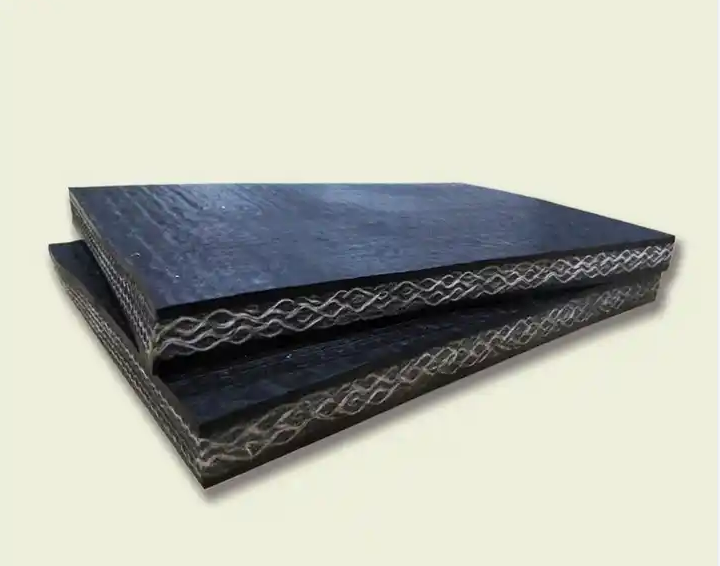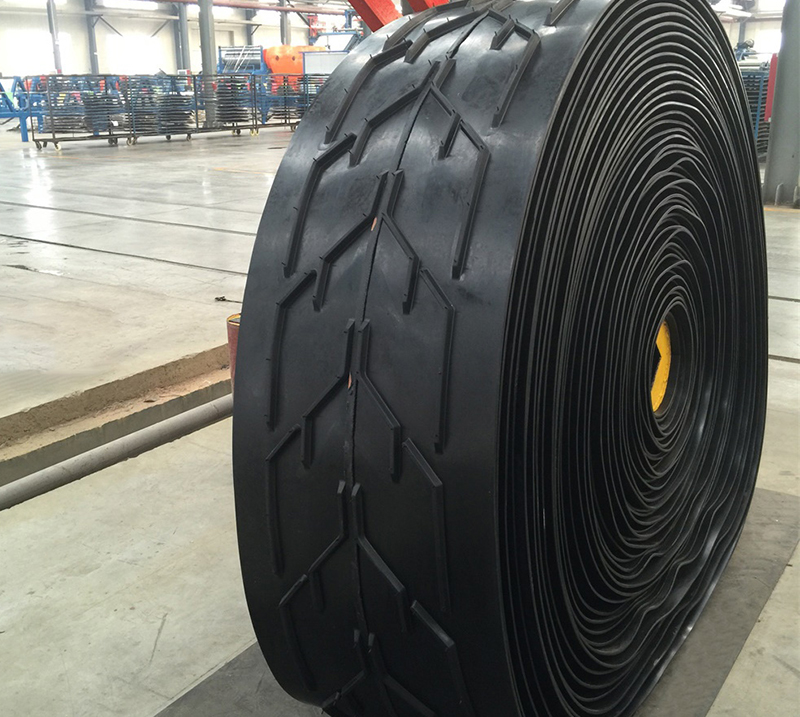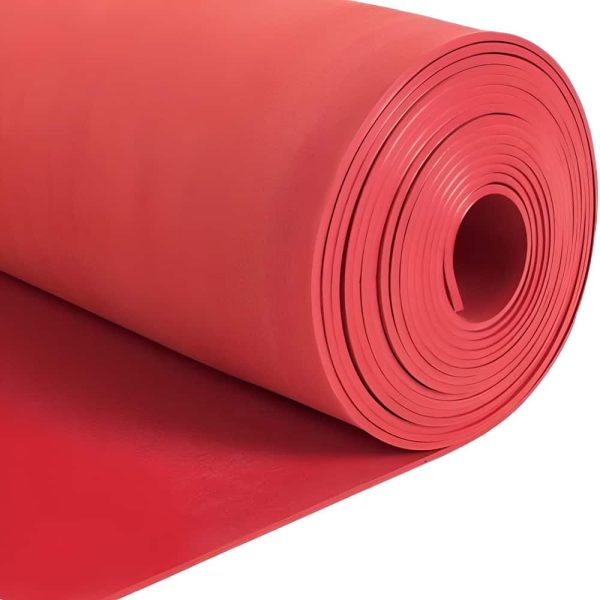UniBelt is a leading manufacturer and supplier of high-quality rubber conveyor belts for various industrial applications. With years of experience and expertise in the field, Rubber Conveyor Belt Ltd. has become a trusted name in the industry. Our team of professionals is dedicated to delivering top-notch products, providing excellent customer service, and offering competitive prices.
Our company offers a wide range of rubber conveyor belts that cater to a variety of industries such as mining, cement, steel, and agriculture. Our belts are made of premium quality rubber materials that ensure high strength, flexibility, and resistance to abrasion. We also offer various belt designs, including straight warp, steel cord, and fabric ply, to suit different load capacities and operating conditions.
In addition to traditional rubber conveyor belts, we also specialize in producing heat-resistant, oil-resistant, and flame-retardant belts for specialized applications. Our belts are designed to withstand extreme temperatures, harsh chemicals, and other challenging environments, making them suitable for a wide range of industrial processes.
At UniBelt, we are committed to providing our clients with the best possible products and services. Our state-of-the-art manufacturing facility and strict quality control measures ensure that our belts meet international standards and exceed customer expectations. We also offer customized solutions to meet the unique requirements of our clients. Our team works closely with customers to understand their specific needs and provide tailored solutions that meet their exact specifications.

The Rubber Conveyor Belt is a type of conveyor belt made from rubber materials. It is commonly used in various industries for the transportation of goods and materials. This durable and flexible product is designed to efficiently move heavy loads over long distances. The rubber material used in the production of these belts offers excellent grip, allowing for efficient and smooth movement of items. With its high tensile strength and resistance to abrasion and impact, this conveyor belt is ideal for use in industries such as mining, construction, and manufacturing. Its flexibility and adaptability make it suitable for use in a variety of environments, both indoors and outdoors. With its high performance and reliability, the Rubber Conveyor Belt is a popular choice for businesses looking for an efficient and reliable solution for their transportation needs.
Rubber Conveyor Belt is an essential component of industrial machinery and plays a crucial role in the transportation and handling of materials and goods. Made from high-quality natural rubber with added reinforcement layers, these belts are designed to withstand heavy loads, high speeds, and harsh operating conditions. They are widely used in various industries, such as mining, agriculture, packaging, and manufacturing, to efficiently move items from one place to another. With its strong grip and flexibility, Rubber Conveyor Belt provides a safe and reliable method for transporting materials and contributes to increasing productivity and reducing labor costs. Its durability and long service life make it a cost-effective solution for businesses worldwide. Enhance your industry's efficiency and productivity with Rubber Conveyor Belt – the ultimate choice for smooth, reliable, and efficient material handling.

Rubber Conveyor Belt. It is commonly used in the transportation and material handling industry for its high strength, durability and flexibility. Our product is made from top quality rubber material, ensuring its superior performance and longevity. Designed with precision and care, it provides efficient and smooth movement of materials, saving time and labor costs. With various sizes and specifications available, our Rubber Conveyor Belt is suitable for diverse applications such as mining, agriculture, and manufacturing. Trust in our reliable product and let it be your ultimate solution for all your conveyor belt needs.
1.What materials are rubber conveyor belts typically made of?
Rubber conveyor belts are typically made of layers of rubber and fabric or steel cords. The rubber layers provide the belt with flexibility and durability, while the fabric or steel cords provide strength and support. The specific materials used may vary depending on the application and desired properties of the belt. Some common materials used in rubber conveyor belts include: 1. Natural rubber: This is the most common type of rubber used in conveyor belts. It is derived from the sap of rubber trees and is known for its high elasticity and resistance to abrasion. 2. Synthetic rubber: This includes materials such as neoprene, nitrile, and styrene-butadiene rubber (SBR). These types of rubber are often used in conveyor belts for their chemical and oil resistance. 3. Fabric: The fabric used in conveyor belts is typically made of polyester, nylon, or cotton. These materials provide strength and stability to the belt. 4. Steel cords: For heavy-duty applications, steel cords are used in place of fabric. These cords are made of high-strength steel wires and provide excellent tensile strength and resistance to tearing. 5. Adhesives: Adhesives are used to bond the layers of rubber and fabric or steel cords together. They are also used to attach the belt to the conveyor system. 6. Cover compounds: The outer layer of the conveyor belt, known as the cover, is made of a special rubber compound that provides protection against wear, abrasion, and other environmental factors. Overall, rubber conveyor belts are made of a combination of materials that work together to provide strength, flexibility, and durability for various industrial applications.
2.How do you prevent tracking issues with a rubber conveyor belt?
1. Regular Maintenance: Regularly inspect and maintain the conveyor belt to ensure it is in good condition. This includes checking for any tears, cuts, or damage to the belt, as well as ensuring proper tension and alignment. 2. Proper Installation: Make sure the conveyor belt is installed correctly and according to the manufacturer's instructions. This includes ensuring the belt is properly tensioned and aligned. 3. Cleanliness: Keep the conveyor belt and surrounding area clean to prevent debris or buildup from causing tracking issues. 4. Proper Loading: Ensure that the material being transported is evenly distributed on the conveyor belt. Uneven loading can cause the belt to track off-center. 5. Belt Tracking Systems: Consider installing a belt tracking system, such as a tracking strip or v-guide, to help keep the belt aligned and prevent tracking issues. 6. Training: Train employees on proper conveyor belt operation and maintenance to prevent any mishandling that could lead to tracking issues. 7. Regular Inspections: Conduct regular inspections of the conveyor belt to identify any potential tracking issues and address them before they become a bigger problem. 8. Proper Belt Selection: Choose a conveyor belt that is suitable for the specific application and environment to ensure it can withstand the conditions and minimize tracking issues. 9. Address Any Issues Promptly: If you notice any tracking issues, address them promptly to prevent them from getting worse and causing damage to the conveyor belt or other components.
3.How do you troubleshoot common problems with rubber conveyor belts?
1. Belt Slipping or Misalignment: This can be caused by improper tension, worn pulleys or rollers, or debris buildup on the belt. Check the tension and adjust if necessary, inspect and replace worn pulleys or rollers, and clean any debris from the belt. 2. Belt Tracking Issues: If the belt is not tracking properly, it can cause uneven wear and damage to the belt. Check for any obstructions or buildup on the pulleys or rollers, adjust the tension, and make sure the belt is centered on the conveyor. 3. Belt Damage: Tears, cuts, or punctures in the belt can be caused by sharp objects or excessive tension. Inspect the belt regularly for any signs of damage and replace it if necessary. 4. Excessive Noise: If the belt is making loud noises, it could be due to misalignment, worn bearings, or loose components. Inspect and replace any worn or damaged parts, and make sure the belt is properly aligned. 5. Material Spillage: If materials are spilling off the sides of the belt, it could be due to misalignment, worn or damaged skirting, or improper loading. Check the alignment, replace any worn or damaged skirting, and make sure the materials are loaded evenly on the belt. 6. Excessive Wear: Over time, the belt can wear down due to constant use and friction. Regularly inspect the belt for signs of wear and replace it if necessary. 7. Belt Joints: If the belt joints are not properly installed or maintained, they can cause issues such as premature wear or belt separation. Make sure the joints are properly installed and regularly inspected for any signs of wear or damage. 8. Motor or Drive Issues: If the conveyor is not moving at the correct speed or is not starting properly, it could be due to motor or drive issues. Inspect and replace any worn or damaged components, and make sure the motor and drive are properly lubricated. 9. Excessive Vibration: Excessive vibration can be caused by misalignment, worn bearings, or loose components. Inspect and replace any worn or damaged parts, and make sure the belt is properly aligned. 10. Excessive Heat: If the belt is getting too hot, it could be due to excessive tension, misalignment, or friction. Check the tension, alignment, and lubrication of the belt, and make any necessary adjustments.
4.What is the minimum maintenance required for a rubber conveyor belt?
The minimum maintenance required for a rubber conveyor belt includes regular cleaning, inspection, and lubrication. It is also important to check for any signs of wear and tear, such as cracks or tears, and replace any damaged parts as needed. Additionally, the tension of the belt should be checked regularly to ensure proper functioning. It is also recommended to keep the belt free from any debris or foreign objects that could cause damage. Overall, regular maintenance and proper care can help extend the lifespan of a rubber conveyor belt.
5.How do you determine the correct tension for a rubber conveyor belt?
The correct tension for a rubber conveyor belt can be determined by following these steps: 1. Check the manufacturer's recommendations: The first step is to check the manufacturer's recommendations for the correct tension for the specific type and size of the conveyor belt. This information can usually be found in the product manual or on the manufacturer's website. 2. Measure the belt tension: Use a tension gauge or scale to measure the tension of the belt. This can be done by placing the gauge or scale at a specific point on the belt and pulling it until the belt starts to move. The reading on the gauge or scale will indicate the tension of the belt. 3. Consider the application: The tension of the belt will also depend on the specific application it is being used for. For example, a conveyor belt used for heavy-duty applications will require a higher tension compared to a belt used for light-duty applications. 4. Check for proper alignment: Improper alignment of the conveyor belt can also affect the tension. Make sure the belt is properly aligned and not rubbing against any other components. 5. Adjust the tension: If the tension is too low, the belt may slip or sag, while if the tension is too high, it can cause excessive wear and tear on the belt and other components. Use the manufacturer's recommendations and the application requirements to adjust the tension to the correct level. 6. Test the tension: After adjusting the tension, run the conveyor belt for a few cycles and check for any signs of slipping, sagging, or excessive wear. If everything looks good, the tension is likely correct. If not, make further adjustments as needed. 7. Regularly check and adjust the tension: It is important to regularly check and adjust the tension of the conveyor belt to ensure optimal performance and prevent any potential issues. This should be done at least once a month or more frequently for heavy-duty applications.

6.What are the benefits of using a rubber conveyor belt compared to other types of conveyor belting?
1. Durability: Rubber conveyor belts are highly durable and can withstand heavy loads, making them suitable for use in industries such as mining, construction, and agriculture. 2. Flexibility: Rubber conveyor belts are flexible and can be used in a variety of applications, including curved conveyors, making them ideal for use in tight spaces. 3. Resistance to wear and tear: Rubber conveyor belts are resistant to wear and tear, making them suitable for use in harsh environments and reducing the need for frequent replacements. 4. Low maintenance: Rubber conveyor belts require minimal maintenance, reducing downtime and increasing productivity. 5. Cost-effective: Rubber conveyor belts are relatively inexpensive compared to other types of conveyor belting, making them a cost-effective option for many industries. 6. High grip: Rubber conveyor belts have a high coefficient of friction, providing excellent grip and preventing products from slipping during transportation. 7. Noise reduction: Rubber conveyor belts produce less noise compared to other types of conveyor belting, making them suitable for use in noise-sensitive environments. 8. Easy to repair: In case of damage, rubber conveyor belts can be easily repaired, reducing the need for costly replacements. 9. Chemical resistance: Rubber conveyor belts are resistant to a wide range of chemicals, making them suitable for use in industries where exposure to chemicals is common. 10. Customizable: Rubber conveyor belts can be customized to meet specific application requirements, such as size, thickness, and surface texture.
7.How are rubber conveyor belts resistant to wear and tear?
1. Material Selection: Rubber conveyor belts are made from high-quality rubber compounds that are specifically designed to be resistant to wear and tear. These compounds are usually a combination of natural and synthetic rubber, along with other additives such as carbon black, which enhance the strength and durability of the belt. 2. Reinforcement: Rubber conveyor belts are reinforced with layers of fabric or steel cords to increase their strength and resistance to wear and tear. The number and type of reinforcement layers used depend on the application and the amount of stress the belt will be subjected to. 3. Cover Compounds: The top and bottom covers of rubber conveyor belts are made from different compounds that are specifically designed to resist wear and tear. The top cover is usually made from a harder rubber compound, while the bottom cover is made from a softer compound that provides flexibility and cushioning. 4. Impact Resistance: Rubber conveyor belts are designed to withstand impact from heavy materials and objects. They are able to absorb the impact and distribute the force evenly, reducing the wear and tear on the belt. 5. Flexibility: Rubber conveyor belts are flexible and can bend and twist without breaking. This flexibility allows them to adapt to the shape of the conveyor system and reduces the stress on the belt, making it more resistant to wear and tear. 6. Low Friction: Rubber conveyor belts have a low coefficient of friction, which means that they can move smoothly over the conveyor rollers without causing excessive wear. This also reduces the amount of heat generated, which can contribute to wear and tear. 7. Maintenance: Regular maintenance and proper cleaning of rubber conveyor belts can help prevent wear and tear. This includes removing any debris or buildup that can cause friction and damage to the belt. 8. Proper Installation: Rubber conveyor belts should be installed correctly to ensure they are not subjected to unnecessary stress and strain. This can help prolong their lifespan and make them more resistant to wear and tear.
8.How do you repair a damaged rubber conveyor belt?
1. Assess the damage: The first step in repairing a damaged rubber conveyor belt is to assess the extent of the damage. This will help determine the appropriate repair method and materials needed. 2. Clean the belt: Before starting any repairs, make sure to clean the damaged area of the belt thoroughly. Use a mild detergent and water to remove any dirt, debris, or residue. 3. Cut out the damaged section: If the damage is minor, you may be able to repair it by cutting out the damaged section and splicing the belt back together. Use a sharp knife or scissors to cut out the damaged area, making sure to create a clean, straight edge. 4. Splice the belt: To splice the belt back together, use a belt splicing kit or adhesive specifically designed for rubber conveyor belts. Follow the manufacturer's instructions carefully to ensure a strong and secure splice. 5. Patch the damage: If the damage is small, you may be able to patch it instead of splicing the belt. Use a rubber patch and adhesive to cover the damaged area, making sure to smooth out any air bubbles or wrinkles. 6. Replace damaged components: If the damage is caused by a damaged or worn-out component, such as a pulley or roller, make sure to replace it before repairing the belt. This will prevent further damage and ensure the belt runs smoothly. 7. Vulcanize the repair: For more severe damage, vulcanization may be necessary. This involves using heat and pressure to bond the damaged area of the belt back together. It is best to leave this type of repair to a professional. 8. Test the repair: Once the repair is complete, test the belt to ensure it is functioning properly. Run the belt empty for a few minutes to check for any abnormalities or issues. 9. Regular maintenance: To prevent future damage, make sure to regularly inspect and maintain your conveyor belt. This includes checking for wear and tear, cleaning the belt, and replacing any worn-out components. 10. Seek professional help: If the damage is extensive or you are unsure how to repair it, it is best to seek professional help. A trained technician will have the expertise and equipment to properly repair your conveyor belt.

